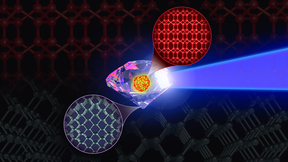LLNL scientist awarded 2015 Fabre Prize
 (Download Image)
Pierre Michel, a physicist at Lawrence Livermore National Laboratory, has been awarded the 2015 Edouard Fabre Prize for his pioneering research into energy transfer between crossing laser beams in National Ignition Facility hohlraums.
(Download Image)
Pierre Michel, a physicist at Lawrence Livermore National Laboratory, has been awarded the 2015 Edouard Fabre Prize for his pioneering research into energy transfer between crossing laser beams in National Ignition Facility hohlraums.
Pierre Michel, a physicist at Lawrence Livermore National Laboratory (LLNL), has been awarded the 2015 Edouard Fabre Prize for his pioneering research into energy transfer between crossing laser beams in National Ignition Facility (NIF) hohlraums.
Named for one of the founders of inertial confinement fusion (ICF) in Europe, the Edouard Fabre prize is awarded to active researchers within 15 years of their doctoral degree. Michel was selected based on his "contributions to studying the physics of laser-driven inertial confinement fusion and physics of laser-produced plasmas." The award, sponsored by the European Cooperation in Science and Technology (COST) Network for Inertial Confinement Fusion, will be presented during the European Physical Society Plasma Physics conference this week in Lisbon, Portugal.
Michel received master’s degrees in physics and photonics from Strasbourg University, France, and a Ph.D. in physics from Ecole Polytechnique in Paris. He worked at Lawrence Berkeley National Laboratory from 2004 to 2006 as an Andrew M. Sessler Postdoctoral Fellow, and joined LLNL in 2006. Since then, he has focused on the physics of laser-plasma interactions to support the NIF ignition effort.
In particular, Michel has served as the lead scientist in charge of studying and modeling cross-beam energy transfer in preparation for some of the first NIF experiments. From these studies, he successfully predicted that the implosion symmetry of fusion experiments could be tuned by relying on self-induced plasma gratings that can redirect laser energy directly inside NIF targets. This technique has been used on almost every NIF shot since then.
The cross-beam energy transfer team received the 2012 John Dawson Award for Excellence in Plasma Physics from the American Physical Society for predicting and demonstrating the technique of laser scatter on self-generated plasma-optics gratings. The technique led to the use of two different laser wavelengths to improve implosion symmetry in NIF ignition targets. The team also received an LLNL Director’s Science and Technology Award in 2012.
The cross-beam energy transfer technique had its genesis in the late 1990s, when physicists noted that laser beams crossing each other’s paths in a plasma could exchange energy. This could potentially degrade the implosion symmetry of implosion targets, a crucial requirement for fusion ignition. This is one of many phenomena known as laser-plasma interactions (LPI), in which the plasma created by a laser can actually interfere with the beam.
Over the following 15 years, the researchers conducted experiments at the University of Rochester’s OMEGA Laser System and developed new physics models to better understand the phenomenon. This led to the conclusion that the energy transfer process could be controlled using slight adjustments to the laser beams’ wavelengths, and even be used as a novel tool to tune the implosion symmetry of NIF targets.
"The work done by (Michel) has turned a potentially deleterious laser-plasma interaction mechanism… into a tool for balancing the spatial distribution of power and energy into an ICF hohlraum," said the Fabre Prize award committee.
Contact
 Breanna Bishop
Breanna Bishop
[email protected]
(925) 423-9802
Related Links
European Physical SocietyEdouard Fabre Prize
European Cooperation in Science and Technology (COST) Network
Tags
Lasers and Optical S&TLasers
National Ignition Facility and Photon Science
Featured Articles







